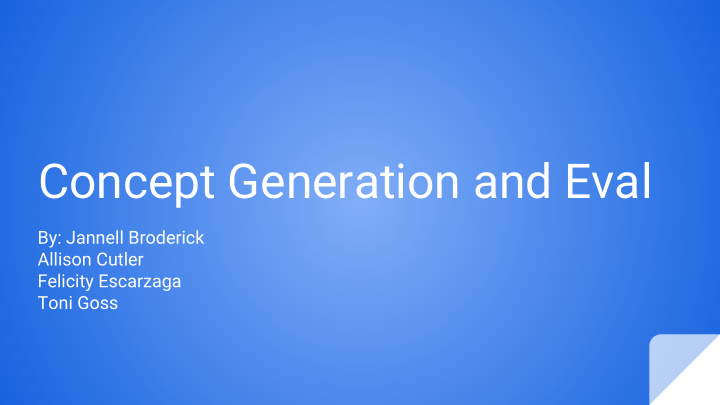



Concept Generation and Eval By: Jannell Broderick Allison Cutler Felicity Escarzaga Toni Goss
Project Description Jannell Broderick
Description: Active Prosthetic This project will provide an affordable prosthetic for below-elbow amputees. It will be able to: ● Be easily replicable by others ● Be sizeable Figure 1: Low-cost 3D-printed prosthetic hand ● Have sense of touch Jannell Broderick
Description: Active Prosthetic Sponsor: Dr Kyle Winfree Director of the Wearable Informatics Lab (WIL) and heads the Go Baby Go project at Northern Arizona University (NAU). Jannell Broderick
Black Box Model The basic customer need is to close the hand to grip item. This requires materials, Energy, and Signals to perform the action. Figure 2: Black Box Model Jannell Broderick
Functional Model Decomposition: Follows the flows of Materials, Energy, and signals to fulfill the customer needs. Concept Generation: the functional models determine components required to complete the customer need. Ex. Batteries, Codes, signal emitters/receivers. Figure 3: Functional Model Customized Hardware Jannell Broderick
Functional Model Figure 4: Functional Model Sense Touch Jannell Broderick Figure 5: Functional Model Electronic Control
Functional Model Figure 6: Functional Model Customized Software Jannell Broderick Figure 7: Functional Model Arm Actuation
Designs Considered Antoinette Goss
Considerations ● Because the design had to be an active prosthetic device, most designs incorporated this aspect as well as the ability to provide haptic feedback and comfort to the user. Some concepts stood out as key designs to consider ● ● These key designs were the adaption, foot controlled arm, and the Capt’n Crabby Antoinette Goss
Adaption Design This sketch was an adaption of a working model already created however it would have added gear and sensing components. It would be used as the datum for our Pugh chart for comparison. Advantages: Disadvantages: ● Provide excellent Haptic ● More difficult to build feedback than other models ● Able to be customised ● Grip is weaker than other designs Antoinette Goss
Foot Control This design would be similar to the adaptation model, however, the controls and sensors would be connected to the foot instead. Disadvantages: Advantages: ● Not easy to build ● More control ● Not the best ability to ● More comfort than other grip objects designs ● Easy to clean
Capt’n crabby This is our bio-inspired design that is based off a crab claw Advantages: Disadvantages: ● Easy to clean ● Does not provide ● Durable successful haptic ● Aesthetically feedback pleasing( fun ● Very heavy theme) ● Not customizable
Other mentions (1)Customizable skeleton- Had a smaller frame but is able to ● 1 send haptic feedback as well as be customised (2)We got you covered- Similar to the skeleton design but with ● 2 a glove to provide better grip and more aesthetically pleasing design 3 ● (3)Drawing Tendons- this hand has wires through the fingers to provide better control for the user, but not as durable as other designs. Antoinette Goss
Designs Selected Felicity Escarzaga
Pugh Chart Felicity Escarzaga
Pugh Chart ● Adaptation was used as the datum ● All designs ranked equal (total = 0) or lower than the Datum. ● Designs selected for Decision Matrix: ○ Customizable Skeleton Foot Control ○ ○ Adaptation We Got You Covered ○ ○ Drawing Tendons ● Other designs with a score of zero were discarded either because they were similar to designs accepted or determined to be impractical such as Cap’n Crabby and You Can Toucan. Felicity Escarzaga
Decision Matrix Felicity Escarzaga
Final Design ● Final design selected was foot control. ○ Includes sensors, which is one of the main requirements of the project. ○ Sensors may be wireless from the foot to the hand to increase comfort. ○ This design requires little effort from the user to open and close fingers. ○ Will be scalable and customizable like current competing designs but will give the user more control. Felicity Escarzaga
Schedule and Budget Allison Cutler
Past-Present Allison Cutler
Present-Future Allison Cutler
Budget ● 4 sensors per Final Design ● Price of Batteries TBD once Motos/Sensors finalized ● EE Team assigned, should know more soon Allison Cutler
Recommend
More recommend